#Linda black elk
Photo



watch Linda Black Elk talk about drying squash. she is so engaging I feel like I could listen to her teach things for hours.
the kitchen is on the ~~hot mess express~~
I’m still learning about canning tomatoes
among other things.
#food preservation#canning#cooking#linda black elk#tired#winter is coming#food#cottagecore#maybe?#projects#diy
7 notes
·
View notes
Text
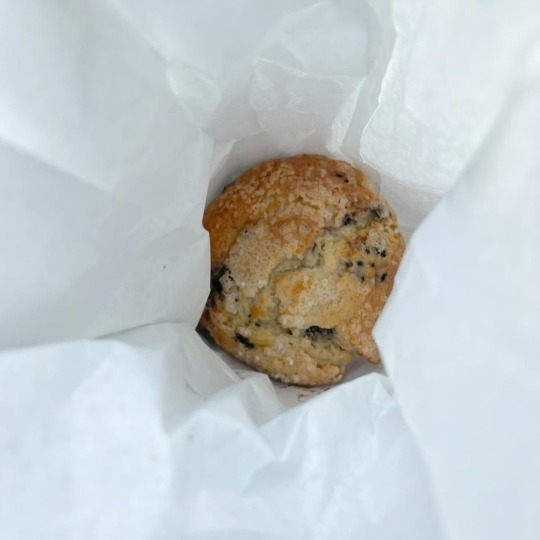
So Luke comes out of Perkins Restaurant and gets in the car with a small bag and he says "I got a blueberry muffin just for being an Indian."
I thought I didn't hear him correctly, so I said "What?" And he repeated himself.
"Ok explain" I said.
"The server asked if I was an Indian. And I said yes. And he said he wanted to give me something so he gave me this blueberry muffin."
So now #Reparation Muffins are a thing.
#RatherHaveLandBack
Credit: Linda Black Elk
6 notes
·
View notes
Text
Okay, I'm not sure how much input Crash Course hosts have over their scripts, but it seems nonzero. Just seems less likely that a science writer picked Linda Black Elk than that Alexis did (unless the writer happens to be a forager fangirl)
0 notes
Link
--- “But, “Linda,” you might ask, “How much water? How much soil? How much sunlight? How deep do I plant it? How often do I sing for it? How often do I pray over it? How rich does the soil need to be? How many of these sweet little seedlings do I need to thin out?”
Listen, while these are all certainly valuable questions, please realize that a lot of our fears - and this goes for any traditional activity from gardening to spearing fish to gathering sacred plant medicines - arise from historic trauma. We have been taught that the ways of our ancestors are scary...that we can’t grow our own food because grocery stores are more civilized...that we shouldn’t cook traditional foods because they don’t taste as good without all the salt and sugar...that we can’t gather our own medicines because we don’t know as much as white doctors...that we can’t educate our children because we aren’t “knowledgable enough.”
The truth is, we must grow our own food and save our own seeds. For decades, gardening has been a hobby, but we must see the agricultural-industrial complex for what it is...and we must take action to reduce our consumption of Big Ag products. Gardening is no longer an “option” for Native peoples. It is an essential activity that our ancestors perfected and that we must perpetuate for the survival of our children.”
-- Linda Black Elk
#gardening#food sovereignty#linda black elk#lakota#grow your own food#indigenous foods#i hope y'all would read the whole thing but i copied in an excerpt that gives you an idea
34 notes
·
View notes
Quote
Foraging is more than just a hobby. It's more than just "free food." Foraging is more than just "what if" in an apocalyptic scenario. Foraging IS all about getting in touch with the land. It is about acknowledging and understanding the ways that our Mother Earth takes care of us. Foraging is all about connection. Foraging is an amazing way to revitalize our cultures. It's a way to recognize those who came before us ... and to stop the erasure of their legacies.
Linda Black Elk
#foraging#women#indigenous#connection#foraged food#wild food#food sovereignty#mother earth#sustainability
481 notes
·
View notes
Text
The Leshii
An old woman from Kaluga Province described the following scene at the time of a forest fire: "I looked, and bears, and with them wolves, foxes, hares, squirrels, elk, goatsin a word every sort of forest life and each in his own group, not mixing with the others, thronged out of the forest and past me and the horses not even looking at us; and behind the beasts with his knout over his shoulder and horn in his hands was 'he himself,' and he was the size of a large belltower." "He himself," of course, is the leshii, and this account captures the essence of the spirit: he is master of the forest and guardian of the beasts within. Like the domestic spirits and other nature spirits, the leshii's primary representation was anthropomorphic; he was envisioned in the likeness of a peasant without a belt who had the power to vary his size and height from that of a blade of grass to that of the tallest forest tree. In Iaroslavl' Province peasants pictured him with the left flap of his kaftan over the right (contrary to Russian custom), his bast shoes on the wrong feet, and glowing eyes; in Tula with wings, a tail, and covered with black fur; in Smolensk as dressed in white or with swollen eyes and a frightened expression.
In addition to black fur, wings, and a tail, such other typical features of the devil as goat hooves and horns were sometimes assigned to the leshii; and in some places one finds the detail that he had no shadow. Accounts usually mention that the spirit carried a cudgel or a knout, a sign of his sovereignty over the forest beasts; in places it was believed that the wrinkles on mushrooms were marks of the leshii's whip. Informants often noted the leshii's power of metamorphosis: he could assume the likeness of a familiar person, a forest beast (wolf, hare, bird), a domestic animal (horse, piglet, rooster), or even a mushroom. In Arkhangel'sk Province a peasant wishing to gain the favor of the forest spirit went into the forest on St. John's Eve, chopped down an aspen tree so that its tip fell to the east, stood on the stump facing east, and bending over and looking through his legs asked the leshii to show himself ''not as a gray wolf, not as a black raven, not as a flaming fir tree," but in human guise.
The leshii made his presence known to peasants venturing into his territory through laughter and handclapping and the various sounds of the forest: the rustle of trees and grass, the chirping and cawing of birds, the growling of beasts, and the whistling of the wind. In places it was reported that the spirit was "dumb," but could sing without words. Other accounts claimed that the leshii, whose most frequently mentioned prank was to cause peasants to get lost, called to a passerby in a familiar voice in order to lure him into a deep thicket or a ravine. Similarly, when the leshii appeared, it was sometimes in the guise of a family member or neighbor. At times, after leading his victim astray, the leshii tickled him to death. Peasants believed that boisterous conduct, sojourning in the woods at night, or crossing the leshii's path by chance angered the forest master, and anyone guilty of the latter offense was sure to lose his way or become ill. Woodcutters, too, were victims of the leshii, who hid their axes or caused their carts or sledges to be rooted to one spot. Other reports tell how the leshii wailed when one of his favorite trees was chopped down.
- Russian folk belief by Linda Ivanits
49 notes
·
View notes
Text
Women’s work is the original subsidy for capitalism. Reproductive labor is necessary for social reproduction [everything it takes for a labor force to replicate itself]: purchasing household goods, preparing and serving food, laundering and repairing clothing, maintaining furnishings and appliances, socializing children, providing care and emotional support for adults, and maintaining kin and community ties. It involves manual, mental, and emotional labor. As more and more people have come to realize during the COVID-19 pandemic, every human being needs this kind of essential work to live. Yet, reproductive work rarely even counts as work at all. Patriarchy teaches that it’s the “natural” role of women, and so, where it is paid at all, it is underpaid.
Women still had their livestock, of course, which allowed them economic autonomy and success: In the 1870s, we had 15,000 sheep; in the 1920s, we had 500,000; and by 1931, we had 2 million. But the colonizer doesn’t want us to be successful, so the federal government conjured up a policy called The Navajo Livestock Reduction, purchasing, removing, and slaughtering our livestock (and arresting those who opposed it). They also set up a grazing system, which ensured we would not be able to grow our herds again and that system is still used today. While this killed the economic autonomy of the Navajo people, it particularly impacted the women because they owned those herds. Men were away working as laborers, while women and their families still relied heavily on the sheep economy to survive. Killing these herds ensured that Navajo women too would have to depend on the wage labor, decisions, and direction of Navajo men.
Where our culture has remained strong, it’s because of Navajo women. And our matriarchs still exist today. Indigenous women are strong leaders, today. People like Enei Begaye-Peter of Native Movement, Wahleah Johns of Native Renewables, and Eriel Deranger of Indigenous Climate Action who have not only dedicated their lives to protecting our homelands but are also advancing real world examples of a just transition away from extractive economies. It’s women like Lillian Hill of Hopi Tutskwa Permaculture Project, Linda Black Elk at United Tribes Technical College, and Nicole Gonzales of Changing Woman Initiative who are learning and sharing our traditional knowledge for the health of our people. It’s women like Ethel Branch and Janene Yazzie of Navajo & Hopi Families COVID-19 Relief who are supporting and keeping our people safe during the COVID-19 epidemic. And there are many others. Because that is our way. It is our job to take care of our home and homelands. And we continue to do that despite patriarchy’s goal to appropriate our autonomy, agency, and power as Indigenous women.
Jihan Gearon
March 11, 2021
#quote#feminism#feminist theory#indigenous feminism#reproductive labor#capitalism#ndn collective#colonialism#settler#navajo livestock reduction#matriarchy#jihan gearon#3.15.21
77 notes
·
View notes
Text
AMERICAN ANIMAL - (January Recap)
Chapter One
Mr Rawling Rump the Rhinoceros, of Austin Zoo, Texas, plunged his large snout into the cool mud and shut his beady black eyes. Rump, as most knew him, let the sludge cool his horn and daydreamed about the coming celebrations. He was excited. The weather had been stifling of late and the party was exactly what the animals needed.
Rump was the oldest mammal in the zoo. His advanced years hadn’t meant he’d learnt humility. Far from it. He was a proud beast who thought a lot of himself, and he wasn’t shy in sharing that around. His enormous enclosure: Rump Ranch, was named by Rump’s father Big Red Rump, and because of its location, next to the entrance, it was considered prime real estate. This made Rump a very important beast indeed. His father Big Red Rump would say:
“You’re a top mammal, son, and you must act like it. The Lion, Tiger, Elephant, Giraffe, Snake, Wolf, Monkey, Gorilla and Bear can afford to mess up. You can’t, the scrutiny is too great.”
Rump had been excited about tonight's chow down for weeks. It was an opportunity to see all of his supporters and also an opportunity for him to gloat. Just one week ago he’d won a triumphant victory over the ruling Big Cats. Rump had repeatedly insisted that President Zanzibar should provide conclusive proof he is an American Animal. Born in an American zoo. Zanzibar eventually relented and Old Baldy, the American Bald Eagle in charge of History and Births, confirm that Zanzibar was indeed born in an American Zoo, although not in Austin zoo. Rump considered the confirmation a victory and took great pleasure in letting his fellow creatures know. Rump’s swaggering self-satisfaction would soon sour.
Rump pulled his horn out of the sludge, climbed on top of Rump Rock, tipped back his head and let loose a thunderous bellow. Simon the snake slunk into the ranch. Simon, a python, was not very long for a python but he was certainly a python. His silvery scales blotched with oblongs of butterscotch yellow, ringed by lines of burnt orange.
Rump and Simon stalked and slid up the shallow slope to the Big Cat enclosure, where tonight’s stomp would take place. Under the giant arches, they went and into the vast and beautifully maintained Palace. Rump nodded cordially in return to those that greeted him. He took his place next to Senator Elena Forde’s enclosure. Elena, a sleek snow Leopard, nodded coldly toward Rump. They’d been friendly once but things had curdled since Rump had attacked her party leader. President Zanzibar, the Lion, climbed onto the speaking slab and addressed the crowd of gathered animals. Rump gazed up at the leader with barely masked disdain.
President Zanzibar looked down and smiled. “It is wonderful to be here with you at the chow down. As you will have heard Old Baldy released my official origin story and I am officially an American Animal. I was born in America!” The animals snorted in support around Rump. Zanzibar smiled more broadly now. “I hope it puts the doubts to rest but in case there is still any uncertainty, Old Baldy said he will give Mr Rawling Rump a blow by blow campfire retelling of my birth story. He’s called it out of Africa.” The animals laughed with great enthusiasm and Rump felt consumed with humiliation. His horn hot with embarrassment.
Zanzibar put up his paw to quell the laughter. “I should add that my mother was not African. She was born in New York Zoo…” Zanzibar now gazed openly at Rump. “Is New York okay or do I need to get Old Baldy to confirm my mother’s origin story too?” Rump’s eyes watered in shock, feeling the crowds communal stare upon him he attempted to smile back with casual grace. As if he’d been in on the joke. Only an awkward grimace was raised. Which only served to stoke the fire of mirth. President Zanzibar called for the stomp to begin and the animals, in unison, began to thud the ground with hooves and paws, trotters and claws. Rump turned to see Simon beating his diamond-shaped head against the ground with concentrated and joyous enthusiasm. Rump gave the snake a contemptuous glance and made his way out of the palace, through the entranced and stomping animals. He trudged back down the hill to Rump Ranch. With every step the rhinoceros’ fury grew, his stubborn will bent on revenge.
Chapter Two
Rump spent three weeks plotting. June ushered in a ferocious temperature and with it a resolve to get revenge done. The rhino climbed onto Rump Rock, tipped back his enormous head and roared. Simon slithered into the enclosure in record time. “Simon, I want you to gather all the animals together and tell them to come to Rump Ranch.” “Of coursssssse,” Simon hissed. “May I enquire as to what we will be discussing?” he said gazing up at the rhino with a colourless smile.
Rump snorted through bucket-sized nostrils and the python wished for eyelids. "This zoo is not great, not great at all. The zoo in Houston and the one in San Antonio are way better, way way better. Which is just terrible. Now go gather the other animals. I’m going to make some changes around here."
“Of courssssse?” said the snake. “But how do you know?" "Old Baldy told me,” Rump said impatiently.
“He wouldn’t lie to me. He’s a true American Animal." Old Baldy, the American bald eagle, visited zoos all over the state. Animals gathered around the ‘news tree’ most nights to hear Old Baldy broadcast the truth. Simon had not heard the claims their zoo was inferior to others but that didn’t mean it wasn’t true.
"President Zanzibar will surely do something," said the snake.
Rump shook his gnarled head, his yellow straw wig flapping, his beady black eyes rolling and his red necktie swinging.
"That pampered lion won't do a damn thing about a damn thing. He isn’t even a true American Animal. You heard him say his mother was African. He admitted it. How can he be our President if he wasn’t even born in an American zoo?"
“But Old Baldy said he was an American Animal.”
“Do you believe everything you hear?” said Rump.
Simon thought about this. Something deep in his slippery stomach told him Old Baldy had confirmed Zanzibar was an American Animal but perhaps he had it wrong. Did he believe everything he heard? Perhaps he did! One thing was for certain, Rump had never ever lied to him.
“Your right of course,” Simon said. “I will gather the animals. Although I’m not sure the Big Cats will come.” Rump settled the snake a beady glare.
“Tell them exactly what I say. Tell them I am going to clean this crooked zoo up and make it great again. Tell them I’m starting with the big furry hairballs in the White Palace. I’m going to cough them up and use them as earmuffs.”
Simon didn’t understand but nodded all the same. He knew Rump was talking about the ruling big cats but he didn’t know what a hairball was. As he slithered up the hill to deliver the message his thoughts turned to food. Most specifically, lunch.
The reptiles arrived first: Mike the lizard, Toby the toad, Gordon the gecko, Linda the turtle, Eric the skink, Charlie the chameleon and Crazy Tom the one-eyed crocodile, all settled down in the soft brown earth in front of Rump Rock and chattered excitedly as they waited for the great horn (as they called Him) to speak. Rump gave his loyal supporters an exaggerated wink, the enthusiastic reptiles grinned and all winked back. Apart from Tom, the crazy one-eyed crocodile, because a crazy one-eyed crocodile can’t wink.
Next to arrive was the sleek snow leopard, Senator Elena Forde. A senior member of Zanzibar’s administration and the Big Cat Patriot Party, she sashayed into the ranch with what Rump dubbed “arrogant cat syndrome”. Senator Forde climbed the leafy sweetgum tree that stood at the centre of Rump Ranch, stretched her limbs over a thick branch and began to preen her paws. She regarded Rump lazily and said: "What are you going to moan about this week?"
Before Rump could respond with nuclear indignation the heritage mammals ambled through the gates and into the enclosure. Joshua the giraffe, Gaga the albino chimpanzee, Jape the gorilla, Lenny the gazelle, Zee the zebra, Sally the hippo and Archer the toothless baboon. Trailing after them, like a vast grey cloud, plodded, Jacob the African elephant. A kindly and steadfast beast. Jacob was one of President Zanzibar’s most trusted supporters and a well-respected member of the zoos community. He was not known for his quick wit but was universally liked for his honesty, affability and tireless work ethic.
The heritage mammals supported the president with dutiful deference, Jacob going further with a belief that Zanzibar possessed almost godlike powers. The heritage mammals had always aligned themselves with the big cats. Since the dawn of zoos.
After the mammals, came the natives: Butch bear, Woody elk, Hank wolf, Buzz coyote, Rocky raccoon, Henrietta red fox, and Ace the three-legged bison. Rump loved the natives because in many ways he wanted to be one, and the natives loved him back because in many ways they thought he was one of them.
Old Baldy glided into Rump Ranch and landed gracefully on a branch high up in the leafless sweetgum. His friends from the menagerie had already taken up lower positions in the tree. Eric weaver, Sarah parrot, Dodger cockatoo and Reginald falcon were all thinking the same thing: if only the other animals could gain their elevated perspective, they might grasp how ridiculous Rump was, and not hang off his every pompous word.
Next came the rodents. Rump had long labelled them “aliens” because they’d arrived at the zoo from other countries, many of them illegally, or so the rhino claimed. Mohammed meerkat, Zoya mongoose, Ali otter, Baba porcupine, and Jose the Mexican rat. Strictly Jose was a Mexican sereque but only his fellow aliens bothered to learn the distinction. The rodents hung back, near the exit, unsettled and nervous. Ever watchful.
Finally, President Zanzibar wandered through the gates of Rump Ranch, his big cat cabinet marching in behind him. Seven senators: tiger, leopard, panther, jaguar, cougar, puma and cheetah. All lived and worked with the President at The White Palace.
Zanzibar moved through the crowd greeting creatures with an easy smile, the animals beamed back in delight. Only when Zanzibar was sitting on his hind legs, his lustrous golden mane angled upward toward Rump, did the rhino begin his speech…
The lion turned and gave the audience a warm smile and then turned back and looked up at Rump.
“Are we not all aliens in our own way?” His commanding voice silencing the commotion.
“My parents came to New York zoo from Tanzania many years ago. I am a first-generation lion. Does this make me any less of an American animal?”
The big cats and mammals roared in support. Rump shook his horn and looked out toward the assembled crowd.
“You’ve ruined this zoo with your woke snowflakery, Zanzibar. For eight years we have suffered at the paws of your administration. Whilst only the elite or the lowly are cared for. What about the animals in the middle? Enough is enough. We need change. I will do a better job than you. We must make this zoo great again. Do you accept my challenge?”
The gathering of animals roared, snapped, yelped and hissed. Some were noises of support, some of opposition, but all agreed that this was an audacious challenge. Zanzibar had never been opposed before, not even by another big cat, let alone a rhinoceros wearing a straw wig.
After a thoughtful pause, President Zanzibar raised his mane and addressed the gathering.
“It is Mr Rump’s right to challenge me.” He turned his flecked auburn eyes on the rhino. “But I will not stand against you. Another will take my place.” He nodded toward the Leopard lounging in the tree. “I choose Senator Elena Forde to run against you in my stead.”
A clamour of surprise and excitement erupted from the crowd. For the first time in almost a decade there would be an election and on the ballot paper a rhinoceros. Rump let out a high-pitched squeal, a noise that male rhinos are well known for, but try to avoid emitting because they think it’s emasculating. Rump pulled himself together, puffed out his cheeks and thought it through. It was unlikely he would win, the big cat elite was too powerful, their supremacy stretched too far back. However, he was in the race and anything can happen when you’re in the race. Then it came to him, a revelation. He wasn’t a big cat and as such he didn’t need to play by their big cat rules. He cleared his throat and began his acceptance speech.
“I accept any challenge set before me,” Rump began. “and I will fight, fight, fight to expose the lies and corruption the big cat elite have committed for so many years. But, you know what’s more important than anything?” he paused to rear up on his hind legs, delighting the reptiles at the front. “Unity! And you know what I love about it?” Continued Rump. “Unity is love, I’m in love with myself, I’m in love with all of you and I’m sure as hell in love with this zoo. And I don’t just love the animals that already support me, I love the animals that have cat yolk in their eyes. Yeh, that’s right, I’m in love with you because I know you love me right back. Deep down, even if you don’t know it yet. We’re all in love together because we all have one thing in common,” he paused again, glancing toward the exit where the rodents stood nervously watching. “Well, not all of us…and do you know what that thing we have in common is?” he bellowed.
Rump waited a beat and then thundered his final line with slow and purposeful intent. “WE ARE ALL… AMERICAN ANIMALS!”
As the new presidential candidate climbed down from the Rump Rock, a chant started up. Two words. Over and over again: “AMERICAN ANIMAL, AMERICAN ANIMAL, AMERICAN ANIMAL, AMERICAN ANIMAL.”
Chapter 3
Rump could not sleep that night; he replayed the day's events with growing delight. Excited and restless in his luxurious straw bed. He’d played it perfectly, he’d been cunning, calm and courageous. He knew the odds were stacked against him, but that didn’t matter. If he could just convince half the heritage mammals to vote for him, he’d be in with a chance of prickling some fat cat fur. Besides, win or lose, he was in the game and his daddy had always said:
“Once you get in the game, you can change the rules.” His daddy had also told him: “Winning ugly is still winning.”
It had been decided that the vote would take place in three weeks time. Rump’s campaign strategy was a simple one. Shake the tree and see what falls out. He was going to make sure that this election would be bigger than anything the zoo had ever seen before. It wouldn’t just be unique because Forde was the first female candidate to be selected in the history of the zoo and Rump was the first non-big cat to be selected. It would be unique because Rump intended to break with convention. In fact, he hoped he could break convention altogether. As he lay awake, staring up at the moon, he compiled a list of one ultimate and unbreakable rule: No matter what, however much the big cat elite pressured him, or how compelling the evidence against him was, he would never ever admit he was wrong. About anything. Ever.
One of the first executive decisions the rhino made was to make Simon Python his chief advisor. The other reptiles respected Simon and keeping them onside would be vital. Rump felt sure Simon would make an excellent right-hand snake. Not least because Rump knew he would do everything he asked, without question. He also chose Simon because he was almost as committed to expelling the alien animals as he was. The reptiles had always felt like they’d been treated as second class citizens by the big cat elite, they’d grumbled about it for years. Rump, who once boasted that his Ranch was twice the size of the reptile house, took the decision to make the refurbishment of the herpetarium (reptile house) his first election promise. He would hold a big rally that very day and announce the exciting news.
Rump commenced a run of rallies that quickly became the hottest ticket in town. His impassioned speeches sparking a conversation that divided opinion, animals and even, in some cases, species. Rump railed against the big cat elite with sincere passion, his mischievous charisma and disarming candidness winning over many doubters. He exploded with policies. Opinions that dared talk about real issues; overpopulation, sanitation and animal migration. His election pledges ranged from the wacky and wild to the inspired and necessary. He threatened to dig a vast trench around the zoo to stop the alien rodents getting in. He promised to make all carnivores pay more tax, a vow the big cat elite were most upset about. Rump was vague and direct, unpredictable and cocksure, but most of all he was plain-speaking, no-nonsense and different.
Rump told the animals that if they had a problem, he would fix it. He didn’t get bogged down in detail, he simply said it would be dealt with. If he said a group of animals were corrupt, they were corrupt. Rump didn’t get involved in evidence. Rump dealt in fact. He didn’t get embroiled in proving things; that was what the big cat elite did. He didn’t have time to waste on verifying particulars. Why should he? He knew exactly what was going on. His supporters took his word for it. He didn’t tell them how everything would get better. It just would. Every speech he gave, audience members either chanted and cheered, or heckled and booed. It was a polarisation so stark many animals worried there would be civil war. The middle ground vanished, you were either with him or against him. His detractors were ardent, his followers evangelical.
Every Rump rally ended with the same repetitive chant: “AMERICAN ANIMAL, AMERICAN ANIMAL.”
The rhino climbed onto Rump rock spurred by the sound of fanatical cheering, he gazed out at the assembled animals, his straw wig flapping in the wind. He was pleased to note the new faces. Every day more were drawn to his rallying cry. “We need big talk and even bigger action,” Rump began with intensity.
“BIG TALK, BIGGER ACTION.” Chanted the crowd back at him.
Rump had travelled around the zoo, visiting with animals from all walks of life, talking to them directly, listening to their grievances, promising swift justice or instant resolution. He injected his speeches with their concerns:
“American animals must come first! Let’s make this zoo great again!” he bellowed, waiting a beat so the gathering mob could chant his words back.
Rump awoke on the sixth day of the campaign with an idea. He summoned Simon and instructed him to go and find him a chalkboard. Within an hour Simon slithered back into the ranch, dragging behind him, a thin sheet of grey slate stone.
“Place it at the entrance of the ranch, where all can see it,” commanded the rhino. Rump followed Simon outside to make sure the snake completed the task to his satisfaction.
“What is it for, Mr President-Elect, Sir?” Simon said as pushed the flat stone into place. “I will use it to communicate my important message, direct to the other animals.”
“What a truly ingenious idea, Sir.”
Rump craned his neck and started to write on the board, with his horn. Simon spoke the words as he spoke them: “A leopard can’t change his spots. I don’t have spots!”
The snake wagged his tail excitedly. “What will you call this new form of communication, Sir?”
“Well, let me see, this is a Horn Board!” Rump said kicking the slate tablet. “So I guess the act of committing thoughts to the Horn Board is called Horning,” he added.
The following morning, Rump went to check the Horning Board and was surprised to find a rather large pile of flat stones stacked at its base. Closer inspection revealed each of the slate tiles was etched with a message.
The first of which was written in tall spidery lettering and was signed by the Mexican Sereque, Jose. It was a straightforward opinion: “You’re an idiot!”
---------------------------------------------------------------------------------------------------
The cover art that received the highest number of likes for the month of January:

Quentin Blake
6 notes
·
View notes
Photo

[TASK 170: LUMBEE]
In celebration of November being Native American Heritage Month, here’s a masterlist below compiled of over 90+ Lumbee faceclaims categorised by gender with their occupation and ethnicity denoted if there was a reliable source. The Lumbee are a Native American tribe from North Carolina, South Carolina, Tennessee, and Virginia. If you want an extra challenge use random.org to pick a random number! Of course everything listed below are just suggestions and you can pick whichever faceclaim or whichever project you desire.
Any questions can be sent here and all tutorials have been linked below the cut for ease of access! REMEMBER to tag your resources with #TASKSWEEKLY and we will reblog them onto the main! This task can be tagged with whatever you want but if you want us to see it please be sure that our tag is the first five tags, @ mention us or send us a messaging linking us to your post!
THE TASK - scroll down for FC’s!
STEP 1: Decide on a FC you wish to create resources for! You can always do more than one but who are you starting with? There are links to masterlists you can use in order to find them and if you want help, just send us a message and we can pick one for you at random!
STEP 2: Pick what you want to create! You can obviously do more than one thing, but what do you want to start off with? Screencaps, RP icons, GIF packs, masterlists, PNG’s, fancasts, alternative FC’s - LITERALLY anything you desire!
STEP 3: Look back on tasks that we have created previously for tutorials on the thing you are creating unless you have whatever it is you are doing mastered - then of course feel free to just get on and do it. :)
STEP 4: Upload and tag with #TASKSWEEKLY! If you didn’t use your own screencaps/images make sure to credit where you got them from as we will not reblog packs which do not credit caps or original gifs from the original maker.
THINGS YOU CAN MAKE FOR THIS TASK - examples are linked!
Stumped for ideas? Maybe make a masterlist or graphic of your favourite faceclaims. A masterlist of names. Plot ideas or screencaps from a music video preformed by an artist. Masterlist of quotes and lyrics that can be used for starters, thread titles or tags. Guides on culture and customs.
Screencaps
RP icons [of all sizes]
Gif Pack [maybe gif icons if you wish]
PNG packs
Manips
Dash Icons
Character Aesthetics
PSD’s
XCF’s
Graphic Templates - can be chara header, promo, border or background PSD’s!
FC Masterlists - underused, with resources, without resources!
FC Help - could be related, family templates, alternatives.
Written Guides.
and whatever else you can think of / make!
MASTERLIST!
F:
Rhiannon Giddens (1977) Lumbee, Occaneechi, Seminole, African-American, Irish, Scottish - singer-songwriter, violinist, fiddle player, and banjo player.
Jana / Jana Mashonee (1980) Lumbee / Tuscarora - actress, singer-songwriter, and author.
Charly Lowry (1983) Lumbee - singer-songwriter.
Queenetta Moore (1983) Lumbee, Unspecified Black - instagrammer (naturallyqueenie).
Stacy Layne Matthews (1984) Lumbee - tv personality. - Trans!
Carmen Hart (1984) Lumbee - actress, model, and former porn actress.
Maria Sturm (1985) Lumbee, Tuscarora, German - filmmaker and photographer.
Grace Askew (1986) Lumbee / Ojibwe - singer-songwriter.
Mackenzie Rosman (1989) Lumbee, Scottish, English, Swedish, Alsatian German - actress.
StyledbyKami (1990) Lumbee, Cherokee, Unspecified Black - youtuber.
Candace Lowry (1992) Lumbee / Unspecified White - youtuber.
Aminah Sane' Ghaffar (1994) Lumbee, African-American - dancer, poet, storyteller, and activist.
Alexis Raeana / Alexis Raeana Jones (1995) Lumbee - singer-songwriter, model, and Miss Lumbee 2015.
Ava Sambora (1997) Lumbee, Scottish, English, German / Polish - actress and model.
Ashton Locklear (1998) Lumbee - instagrammer (_ashtonlocklear) and gymnast.
Raven Dial-Stanley (1998) Lumbee - model, dancer, and Miss Indian North Carolina 2018.
Page Danielle (?) Lumbee - youtuber.
Quania Love Jones (?) Lumbee, Serrano, Miwok, Ohlone, Mexican, African-American, Louisiana Creole - actress, model, and socialite.
Ruby Star Shaman (?) 1/8 Lumbee, 1/8 Cherokee, 3/4 Unspecified Celtic - actress, singer-songwriter, poet, storyteller, and medium.
Jatana Jackson (?) Lumbee - model, Ms Virginia 2018, and Ms Virginia 2015.
Rachel Stewart (?) Lumbee, African-American / Tuscarora, African-American, Irish - visual artist and jewelry designer.
Daphne Coriz (?) Lumbee, Kewa, Yaac Haa’nu - model, makeup artist, and hairstylist.
LotusInWonderland (?) Lumbee, Cherokee, Choctaw, Lenape, Melungeon, Lakota Sioux, Pawnee, Shawnee, Metis, Cree, Chickahominy, Muskogee, Powhatan, Kuči - instagrammer (lotusinwonderland).
India Lowery Jones King (?) Lumbee - model.
Nikki Jacobs (?) Lumbee - plus-sized model (instagram: nikkiplusmodel).
MelodicWaters / Melody The Mystic (?) Lumbee, Muskogee, Choctaw, Sioux, Puerto Rican [Taino, Afro-Puerto Rican] - singer, poet, and reiki master.
Jiffy Caywood-Williams / Jennifer Caywood-Williams (?) Lumbee - reality tv personality, celebrity chef, artist, and designer.
Heather Parker (?) Lumbee, Yakama, Tulalip - singer-songwriter and fashion designer (instagram: urthychurchygirl).
Glenda Bean (?) Lumbee, Catawba - actress.
Nikki Carter (?) Lumbee - plus-sized model.
Kayla Jean Oxendine (?) Lumbee - actress and Miss Indian North Carolina 2017.
Tabitha Leviner (?) Lumbee - model and trainer.
Britt Watt (?) Lumbee, African-American - model, athlete, and trainer (instagram: bwatt3000).
Layla Rose Locklear (?) Lumbee, Tuscarora / Oglala Lakota Sioux - singer.
Amelia Locklear (?) Lumbee - rower.
JoJo Brooks Shifflett (?) Lumbee / Unspecified - author (instagram: alumbeegershom)
Sable J Locklear (?) Lumbee - model (instagram: sablejeanette).
Malinda Maynor Lowery (?) Lumbee - filmmaker and writer.
Linda Cox (?) Lumbee - singer.
Vincea Locklear (?) Lumbee - martial artist.
Chasity Lowery (?) Lumbee - model.
Ashley Minner (?) Lumbee - artist.
Tonya Holy Elk Locklear (?) Lumbee, Oglala Lakota Sioux - artist.
M:
Joe Taylor (1939) Lumbee - football player.
Gene Locklear (1949) Lumbee - baseball player.
Kelvin Sampson (1955) Lumbee - basketball player.
Chief Iron Bear / Harold Collins (1957) Lumbee - powerlifter.
Tatanka / Chris Chavis (1961) Lumbee - wrestler.
Clint Lowery (1971) Lumbee / Slovakian - singer-songwriter, guitarist, bassist, keyboardist, drummer, and producer.
Corey Lowery (1973) Lumbee / Slovakian - singer-songwriter, guitarist, bassist, and producer.
Jammie Deese (1977) Lumbee, Unspecified White - football player.
Dylan Kage (1980) Lumbee - wrestler.
Sean Locklear (1981) Lumbee / African-American - football player.
Kenwin Cummings (1986) Lumbee - football player.
Ryan Van Natten (1987) Lumbee / Dutch - ice dancer.
Keenan Allen (1992) Lumbee, African-American - football player.
Michael Goedel (1993) Lumbee, Yakama, Tulalip - model and dancer.
Lakota John / Lakota John Locklear / John Lakota Locklear (1997) Lumbee / Oglala Lakota Sioux - singer-songwriter and guitarist.
Robby Cummings (?) Lumbee / Cherokee - singer-songwriter and keyboardist.
Noah Hunt (?) Lumbee - singer and guitarist.
Ryan Dial-Stanley (?) Lumbee - flutist and spoken word artist.
Kenny Wingle (?) Lumbee / Polish - comedian.
Efrain Colón (?) Lumbee, Unspecified Latine - screenwriter.
Realbk (?) Lumbee - musician.
Matty Strongbeaux (?) Lumbee, Cherokee, Samoan - rapper.
Gordon Ison (?) Lumbee - actor and filmmaker.
Abraham Thomas (?) Lumbee / Oglala Lakota Sioux - singer-songwriter.
Mark McKinney (?) Lumbee - singer and guitarist (Mark McKinney & Co.).
Andrew Locklear (?) Lumbee - singer and percussionist (Mark McKinney & Co.).
Jonathan Locklear (?) Lumbee - guitarist and bassist (Mark McKinney & Co.).
Dolphus Ramseur (?) Lumbee, Unspecified White - musician and producer.
JaseLVO (?) Lumbee - rapper.
Aaron Locklear (?) Lumbee - guitarist, keyboardist, and drummer (Dark Water Rising).
Corey Locklear (?) Lumbee - guitarist (Dark Water Rising).
Q LeNar / Quincy LeNar (?) Lumbee, Cheraw, Cherokee, Tuscarora - filmmaker.
Zeus Tha God (?) Lumbee, African-American - rapper.
DtK / daveth3king (?) Lumbee - rapper.
Daniel Chavis (?) Lumbee, Unspecified Black - singer-songwriter, poet, and illustrator.
Brandon McLean (?) Lumbee - singer.
Jamie K. Oxendine (?) Lumbee / Muskogee - musician, storyteller, writer, and artist.
Tis Mal Crow (?) Lumbee, Hitchiti, Cherokee - artist.
Hayes Alan Locklear (?) Lumbee, Tuscarora - artist.
Isaac Dial (?) Lumbee / Navajo - artist.
Christopher Simmons (?) Lumbee / Afro-Panamanian - boxer.
Donte M. Williams (?) Lumbee - producer.
Shannon Lowery (?) Lumbee - artist (instagram: mudlowery and ibeshannonlowery).
Jamie Locklear (?) Lumbee, Unspecified Black - podcast host.
Edgar Villanueva (?) Lumbee - author and activist.
James Bixby (?) Lumbee - skater and video creator (instagram: bixbyfilms).
NB:
Qwo-Li Driskill (1975) Lumbee, Lenape, Cherokee, Osage, African-American, Irish - Two-Spirit (Ze/Hir/Hir’s) - performer, author, and poet.
Problematic:
Heather Locklear (1961) Lumbee, Scottish, English, German - actress. - Domestic violence.
Anybody Killa / ABK / James Lowery (1973) 3/4 Lumbee, 1/4 Cherokee - rapper. - Blackface, appropriation of cornrows, and appropriation of bantu knots.
17 notes
·
View notes
Text
Beer and botany
I spent a lovely Saturday morning walking around Luckiamute Meadows, specifically Cliff and Gay Hall's property in King's Valley, for the Greenbelt Land Trust's 2019 Beer & Botany event. I was joined by two of my SCARC colleagues, who are always game for some walking (and beer). We were joined by staff from Greenbelt, 15 or 16 other walkers, and Paul Miller from Sky High Brewing, who shared past beers inspired by these walks and how wild ingredients could be used in beer.
We met at the King’s Valley Charter School, which was established in 1848, and learned more about the history of the school as well as the ways the kids use the area as outdoor school. I will also note that beyond the kids a herd of elk as large as 70 also uses the area.
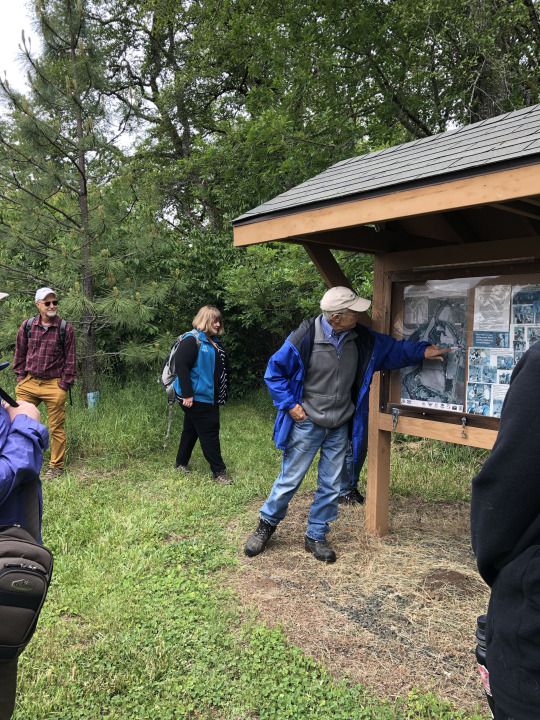
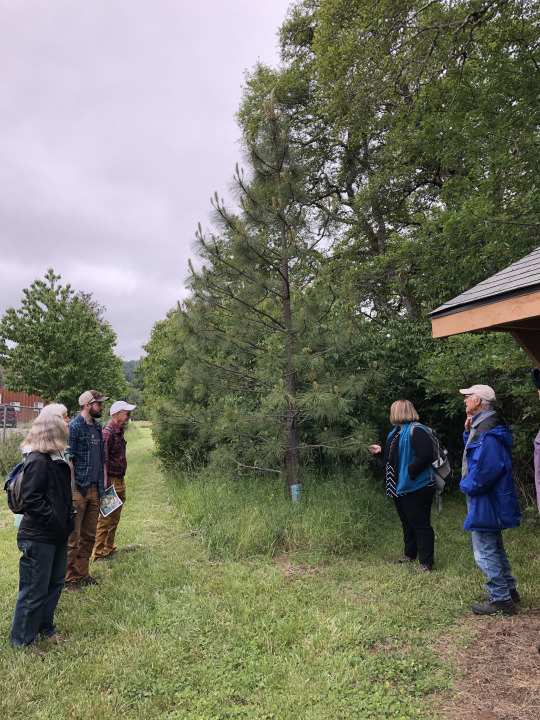
Nahum King arrived in the Kings Valley area in 1847. He was a financier of wagon train from Missouri and who took out a land claim in 1846. You can learn more about the ”Heart for Any Fate” book by Linda Cruz.
The Hall's used to have cattle, but over the past 20 years they have shifted to more active land management and conservation on their property. In partnership with many groups, including the Greenbelt Land Trust, they have planted over 20,000 trees (most? all? of which are native species).
As we walked we learned more about how ingredients all around us could be used in beer. Miller said anything with sugars works, you just need a lot.
"Ethnobotany is the study of a region's plants and their practical uses through the traditional knowledge of a local culture and people."
Spruce tips, rose, lemon balm? Yep. Camas, the starchy tuber used by the native Calopooians? Yep. Fungi? Maybe.

Speaking of traditional knowledge, one of the people on the walk asked about whether Native Americans made beer. Miller said he wasn't sure but he knows they fermented tea made from flowers and leaves; this drunk was used in small amounts mostly during ceremonies.
Two years ago I did a beer/botany walk with this group around the Owens Farm in north Corvallis and Joel Rea from Corvallis Brewing Supply carried a "fermenting bucket" with him to capture the wild yeast. From that he made "Owens Farm Funk," a beer that lived up to its name. Ingredients, including the yeast, capture a sense of place, literally, in the beer that is made from them. It's the terroir, of course.
Other things I learned? They’ve focused on planting Valley Ponderosa Pine, a native to the Willamette Valley, which was almost wiped out due to over logging.
We stopped at Maxfield Creek, which wasn’t really a creek but a gravel deposit when they moved here 20 years ago.
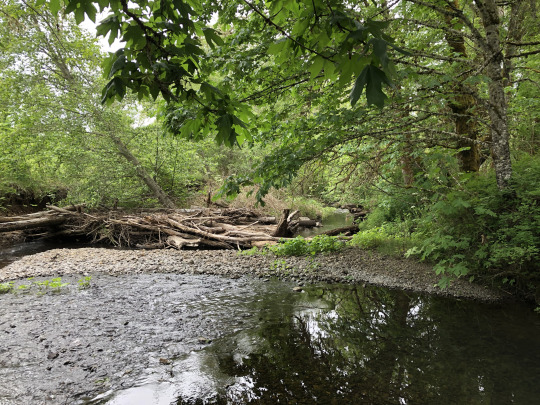
Originally, the creek split into 5 fingers, but farmers wanted to get water out of the fields in early 1900s and they altered the land until there was virtually no water in the creek. Log jams resulted, and the "old timers" cleared these jams out because didn’t think it was good for fish. It turns out that log jams were actually good, and as a result of the cleaning out for a long time the fish population was quite low. Now there are lots of fish (lots of cutthroat trout, steelhead, even coho salmon (!), and lamprey), and they report there are no invasive species. Later in the walk we talked more about the OSU friends in the water. Beavers are here (!), but in this spot they don’t build dams on the creek, instead they burrow into the bank. I also learned that beavers are an indicator species of a healthy watershed.
Beavers gnaw on trees.
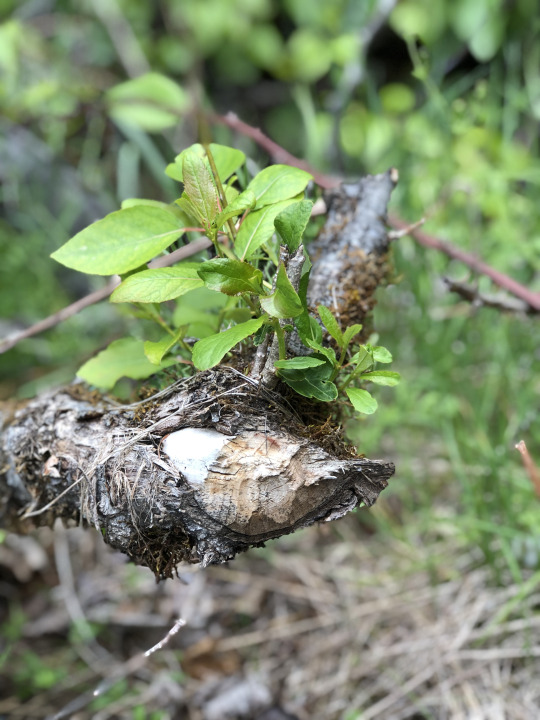
And birds peck at them.

The Hall land was a sheep farm 20 years ago, and besides that there were some big trees and very little undergrowth (because the sheep ate the low stuff). In the future they hope to move away from using chemicals; right now they are spot spraying and trying to find a healthy balance. So it's no surprise that fresh water is number one important for all alcoholic beverages, but Paul talked to us about why brewers work with conservation groups. Beer is directly connected with agricultural as a secondary product, and we all benefit when that product is protected from runoff. The more treatment to land, the more Paul has to do to get it out of water for beer. The treatment he needs to do varies based on which of the two water sources we draw from in Corvallis, what time of day or what time of year it is.
Brewsheds? We didn't talk a lot about them, but I'm definitely keen to learn more about them. Here's the Oregon org: Oregon Brewshed Alliance.
Not directly related to beer, but worth pointing out is this big railroad flat car that runs across the creek, which the cattle used to cross.
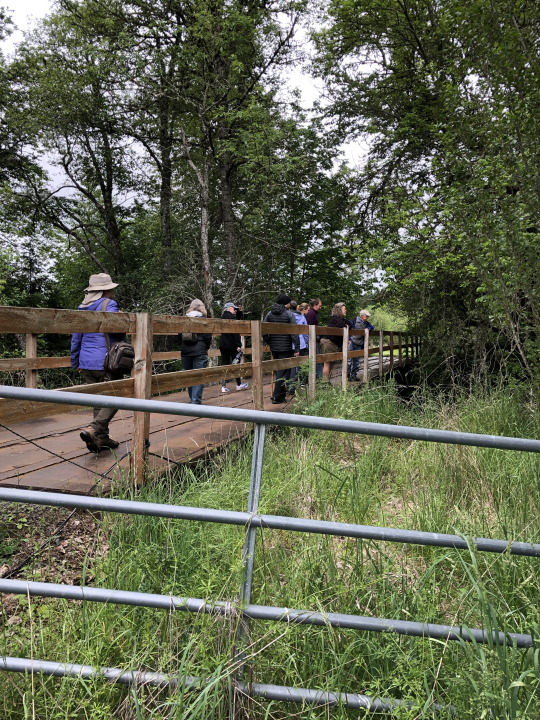
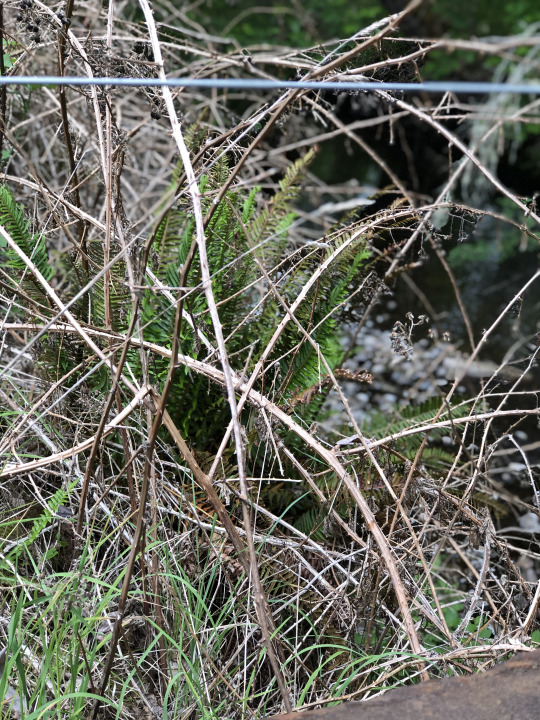
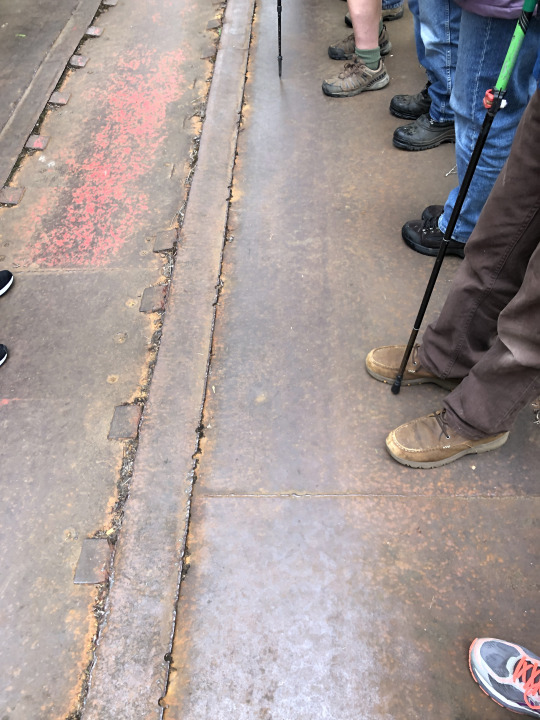
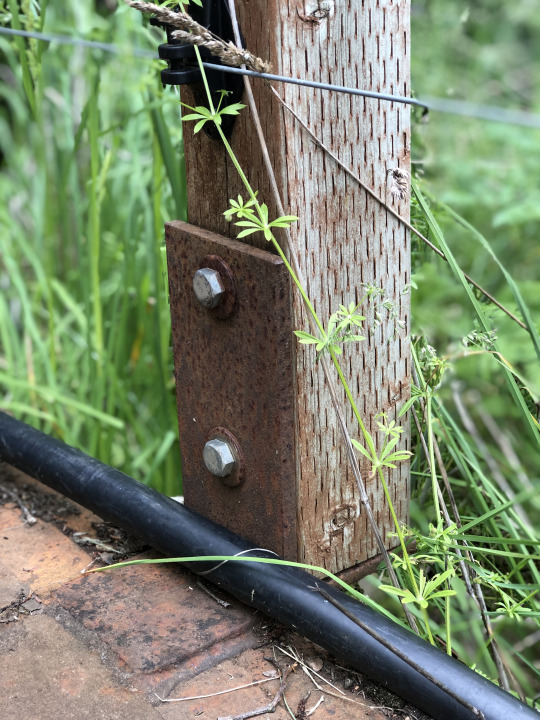
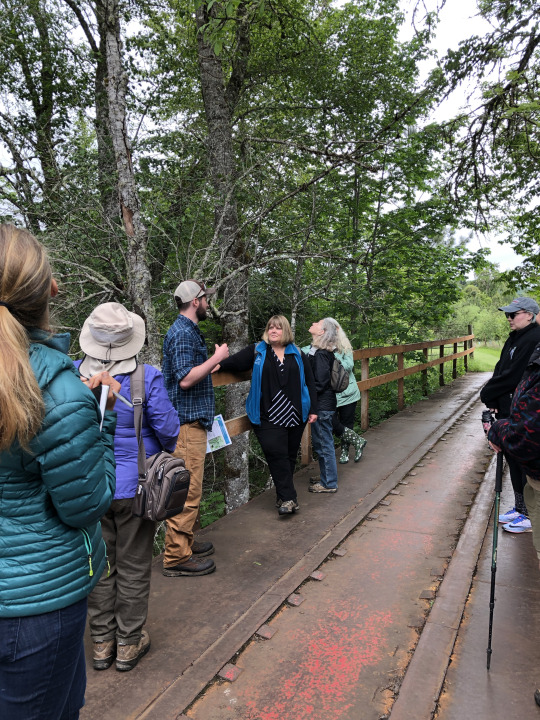
Paul talked more about some of the challenges and opportunities in the brewing world for sourcing new beer ingredients. Referencing that Owens farm walk, he talked about how it inspired him to make a "Strawberry Pinot Tart," which featured local flora and fauna, and how that led to him starting the Sky High barrel aging program in lobby. He's very interested in local ingredients: they get their hops from Crosby, grain from Madras, and yeast from Hood River (which is salmon safe) and Portland (which is organic). Paul (and Sky High) also work to support local organizations that are committed to sustainability, renewability, and biodiversity.
We walked by many lovely trees, including redwoods (they are thinking of climate change wants to plant things that grow in California), Indian plum...
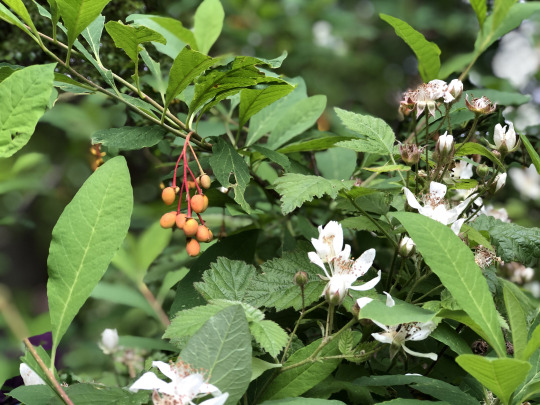
Smaller oaks planted 20 years ago.
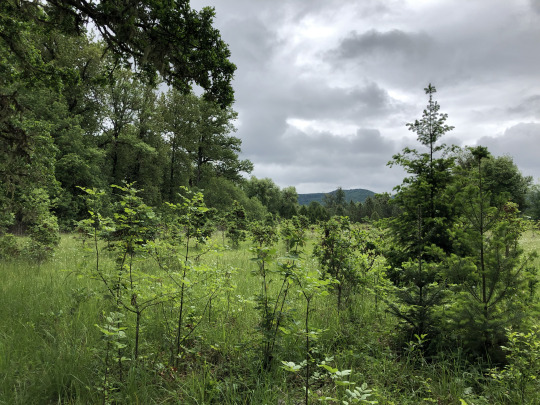
And a wonderfully big and old oak tree. How old is it? There were 260 rings!
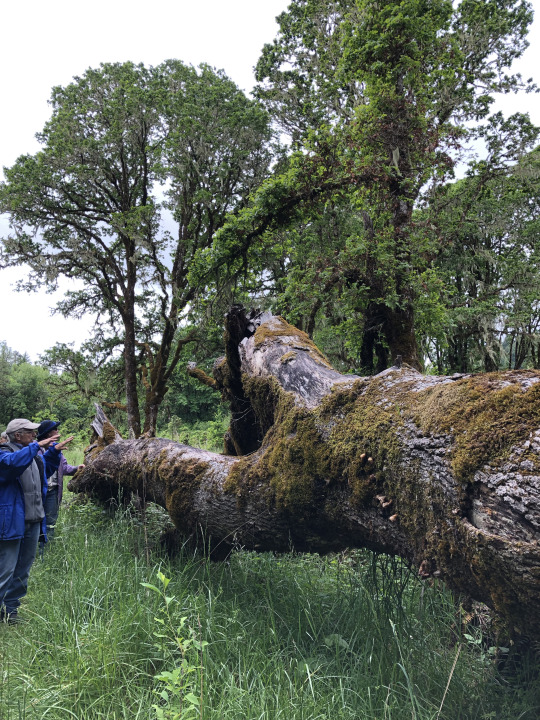
And a little tree growing out of the big tree.
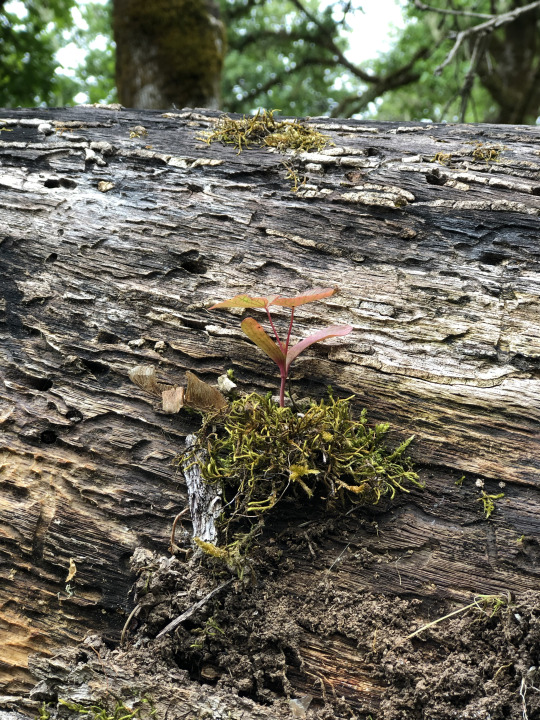
And some mushrooms. Mushrooms in beer? Yep.
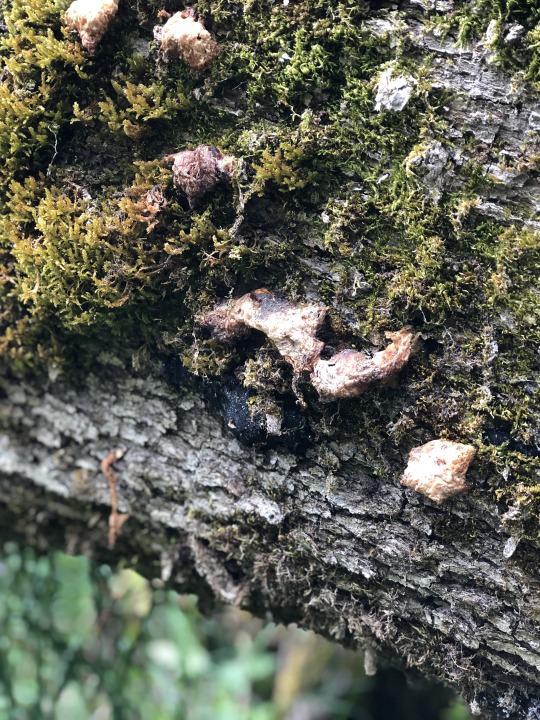
Brewers usually use them as a flavoring agent. I learned that some produce the same chemicals present in tropical or maple syrup flavors. I also learned that some toxins could remain... You have been warned.
We learned that this area is an "oak forested wetland," which was left alone by the farmers because it was too wet for cultivation, is what Oregon used to be like. Sloughs and trees keep streams cool and keep fish fed.
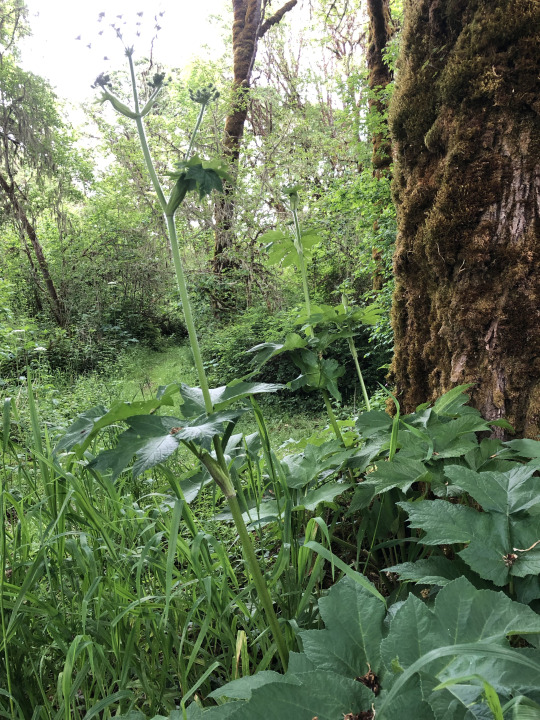
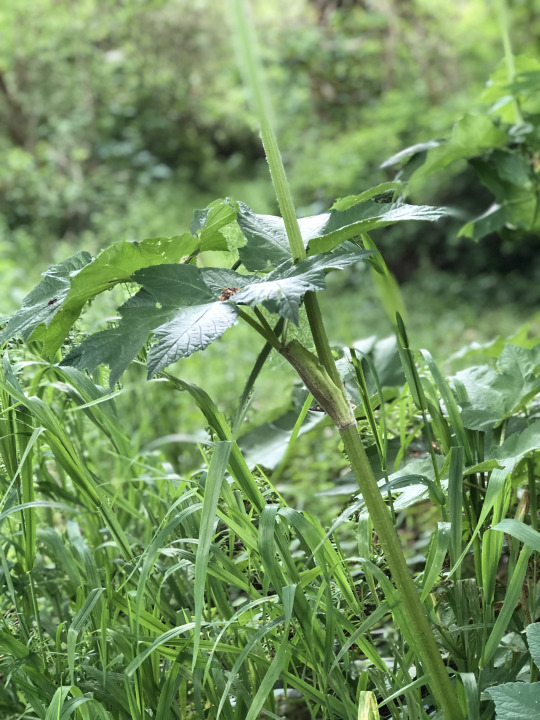
There was also a BIG black cottonwood - maybe biggest in Oregon - and we appreciated our time gazing up at it.

Speaking of oak... You may have heard that people use oak to make barrels. I learned that the Halls planted white oaks, which are taking a long time to grow, and that white oak is the choice for barrels because they are water tight (unlike red oak). Something to do with the veins holding water because they swell and close up? Sky High has sources bourbon barrels from Texas and other southern states, but also from wine barrels used by the winery Spindrift in Philomath and House of Spirits in Portland. This cycle reversed too: bad batches of beer can be given to a distiller. Brewers can reuse these barrels over and over, and they appreciate the different flavors imparted into wood. Paul said that organisms squirrel into wood, dry up, then rehydrate in fermentation.
As we walked more we learned more about the opportunities OSU students have had on the property. A group came out several years ago and prepared a report on native plants - they suggested planting poison oak! We all got a good laugh out of that because no one knew where you’d even buy it.
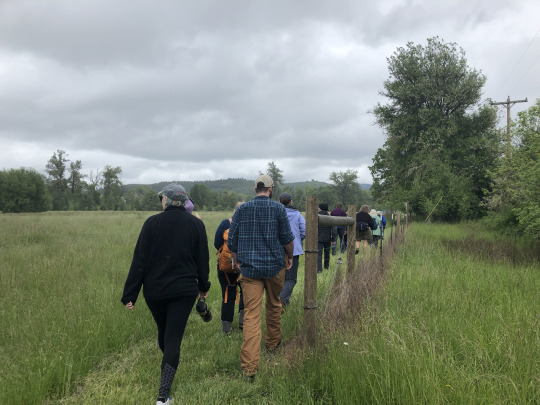
And for those wondering, we had a Blueberry Berlowitz with rose hips.
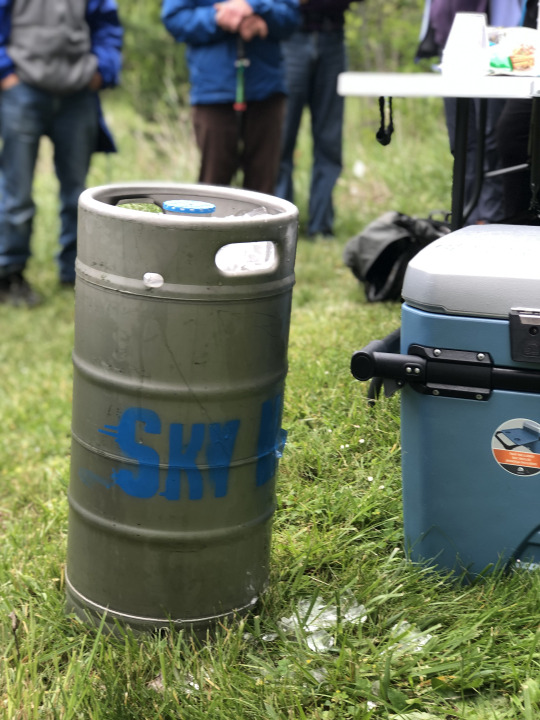
2 notes
·
View notes
Text
Preventing Movements from Being Overlooked in the Age of Activism
Contemporary social movements have a higher chance of fading into the background now more than ever. Benjamin Sáenz, a professor at the University of Texas at El Paso, says “There is no [Chicano] movement per se. That doesn’t mean there is nothing happening” (Guerrero, 61). This holds true for many modern-day movements where people have the Internet to aid in spreading information faster than traditional methods. It’s easy to be forgotten when activists can be branded far-left SJWs (social justice warriors) as a tactic to ignore the message. The racists that many of today’s movements are fighting against can have entire pages taken down after false reports of hate speech. In a country founded on the beliefs of the white, Christian majority we often see the issues that stick are what these people are in direct opposition with – black vs white, gay vs straight, rich vs poor, Christian vs savage. Movements like Black Lives Matter see huge success because they are right – there’s an issue that needs to be addressed – but also because this country thrives on the continued white against black narrative that raises white inhabitants higher on their pedestals. While all social movements of the future have to worry about whether the public regards their goals as positive or negative, it is especially the movements of smaller groups that are vulnerable to being left behind. In addition to the fading of news that inevitably happens with a 24-hour global news cycle, active erasure now occurs with a few clicks.
Because I am not Black, Mexican, or Asian it isn’t my place to speak on the movements of those groups beyond observations of them. I can, however, speak to the many movements of my people. Okla Chahta ohoyo hapia hoke. I am a proud woman from the Choctaw Nation of Oklahoma. All through school I had teachers ask me if I knew that Native Americans made up just 1-2% of the entire United States population. It was hurtful to always be stared at as if I belonged in some sort of museum, and pushed me to look deeper into the needs of Indian Country as a whole. Issues my tribe doesn’t face, others do; and where there is trouble, there is generally a movement to change the cause for a better outcome. Since the very first colony settled on these lands in 1492, Indigenous peoples have been at risk for becoming one of these aforementioned forgotten groups.
Diminishing the power of those who make up today’s 566+ federally recognized tribes was the goal from day one and that’s obvious when you look at our numbers in the broad population. Even so, this has not stopped the fires burning among us. Every day we fight for a different facet of the erasure and oppression we face: Standing Rock, Bears Ears, Mauna Kea, Native mascots, tribal sovereignty, missing and murdered Indigenous women. The goal is to start these movements and prevent them from disappearing before anything can be accomplished. But how can we ensure that when even movements like that of Colin Kaepernick – who had the attention and support of millions of football fans – can be warped and forced out of the spotlight?
Journalist Jacqueline Keeler, of Navajo and Dakota decent, spoke briefly with me on the issue of staying relevant and being heard. Much of her beliefs appear to lie in the idea that our strength manifests in numbers.
I think that it’s not going to be easy and this is not the natural course of things. The exertion of sovereignty [and] something which I really advocate for: an Indigenous tribal government. I think that we need to organize politically because we’re talking about political rights, you know? Our safety, our security, our identity is only going to be protected politically. All of this is permeable as long as we are not politically strong, so we need to strengthen ourselves politically. Obviously we are talking about several hundred different nations, but we are stronger together and we have more at stake in common than we do apart.
Strengthening ourselves politically is an important idea to consider because tribal sovereignty is already ignored in day to day life. We need leaders who aren’t afraid to assert their power, and from there we need to work together to get our best into the U.S. government. Politics are at a turning point where things will either improve for those experiencing injustice or history will repeat itself.
National headlines detailing Standing Rock Reservation and the protection of sacred sites that were desecrated for the Dakota Access Pipeline proves that this idea of strength in unification is on the right track. Standing Rock is shared by Yanktonai Dakota, Hunkpapa Lakota, and Sihasapa Lakota. People from these tribes united and rallied for help in protecting their lands and burial grounds that were being threatened. Tribe after tribe sent letters of support and representatives to aid in the work that was happening up north. I sent packages of supplies to the very first wave of protectors in April 2016 while urging my tribal leaders to pen their support and send help. I observed Linda Black Elk, of the Standing Rock Sioux, use her background in Ethnobotany as an EMT for the protectors. I watched as needed roles were filled and veterans showed up to stand on the front lines following Trump’s executive order that reversed Obama’s protections. Although the pipeline has been completed, the events at Standing Rock are an inspiring example of strength in numbers. If we can come together and turn the public’s attention to the injustices we face, we can come together and work from inside the corrupt system that holds us down.
A Lakota youth advocate, Megan Red Shirt-Shaw, has worked admissions at multiple universities and is using her experience to work on a project designed to connect Natives pursuing their Ph.D. with mentors in their desired field. This came to mind when reading about Sáenz and Guerrero discussing how “Many of the young leaders of yesterday went to school and are now our doctors, lawyers, educators, and writers” (Guerrero, 61). If wielding our collective power to change societal tradition is key to the social movements of the future, avenues to and participation in academia is necessary. Education will be the foot in the door for minorities in politics; without which nothing will change about the lack of diversity in our representatives. The statistics for politicians in the United States proves that the diversity of the country is not reflected. In 2015 I read a Washington Post article titled “The new Congress is 80 percent white, 80 percent male and 92 percent Christian” that went on to detail the exact numbers of the 114th Congress. This country is not in a crisis where our population of women is severely lacking in numbers, so why is it that our government doesn’t more accurately reflect the diversity of the current population? Activism taking center stage in conversations across these lands means more youth are likely to actively pursue higher education and get involved in politics. As these numbers rise there is higher potential for the government to accurately represent this nation’s inhabitants.
By working together toward the ultimate power of representation we will eventually be able to reinvent the foundation of this country without a radical anarchy. And that’s how it should be done – slowly and with enough thought that everyone can benefit – otherwise we run the risk of someone being left out or these lands being damaged further. “Critics will rightly contend that co-management is not an ideal status for tribes. We are indigenous to the land and by right should have complete authority. But the political reality is that we don’t” (Curley, 72). I don’t believe there is a need to speak of something as severe as overthrowing and abolishing the government while minorities are at such a clear disadvantage. Though a nice fantasy to dwell in, a slow trickle into spaces that don’t currently have their doors open to us will be much easier.
While it is less than ideal to have to work so much harder than those currently in power just for the chance to enter their stadium, it’s worth it when we look at the cause. The root of any social movement examined corresponds with lack of power and that’s why we must focus on taking back said power and distributing it where deserved. Without that we will only see movements grow silent and fade out like the Chicano movement and the water protectors at Standing Rock. Movements visible to those who are involved, but otherwise unseen. We can choose to let the media pit us against other movements, break us from the inside, and turn onlookers against us or we can cease to feed that monster and focus on feeding ourselves. The majority will look away when comfortable and it is in those moments that we can choose to stay down where they want us or build up.
Works Cited
Bump, Phillip. “The New Congress is 80 Percent White, 80 Percent Male, and 92 Percent Christian.” Washington Post. 5 January 2017. https://www.washingtonpost.com/news/the- fix/wp/2015/01/05/the-new-congress-is-80-percent-white-80-percent-male-and-92- percent-christian. January 2017.
Curley, Andrew. “Some Thoughts on a Long-Term Strategy for Bears Ears.” In Edge of Morning: Native Voices Speak for the Bears Ears, (pp. 66-73). Jacqueline Keeler. Salt Lake City, Utah: Torrey House Press. May 2017.
Guerrero, Salvador. “The Chicano Movement – Alive and Evolving.” In English One Reader, (pp. 61-62). Charles Brown. (Original work published 2011)
PROMPT: to be added. Blog & posts under construction/revision.
#paper two: social movements#grade: excellent#native american#college#english one#essay#personal#cultural#september 2018
1 note
·
View note
Photo

the fun food projects are neverending. actually, they may end soon, in a temporary, seasonal way. I’ve been doing a bunch of canning/drying/fermenting/whatnot and can finally see my dining room table and the fridge is no longer a crammed mess.
I started some fire cider for the first time (here’s another Linda Black Elk video if ya wannit). The funny thing about medicine like this is that... the next day I made a Thai curry-inspired thing. I say inspired because I didn’t have any curry paste, and made up for it with lime juice and lots of chopped ginger and onions and garlic and some leeks and homemade fermented hot sauce and turmeric etc and eventually I was like hang on, this is just all the ingredients of fire cider. In food. It was delicious. And that, my pally wallys, is what people mean when they say Food Is Medicine. I think probably there are medicinal plants that are more potent, that you wouldn’t just want to chop up and toss in your dinner? Who knows though. I think I like that the line is a little blurry.
On the right are some carrots, happily lacto-fermenting away. These were all the babes left in the ground that didn’t get big enough to go in boxes by the last CSA week and were still too small to donate to food pantries/shares/distros the next week. So I took them home, ate a bunch raw, and packed the rest in a jar with salt water. The tops went into pesto which is now in the freezer.
4 notes
·
View notes
Text
2 notes
·
View notes
Video
youtube
#foraging is my quarantine coping mechanism#linda black elk#capitalism is the worst#food sovereignty
1 note
·
View note
Photo

"My friends Kanahus Manuel, Clayton, Rueben George, and so many others have been standing against this devastating pipeline for so long. I went up there to stand with them and I’m hoping to answer Kanahus’ call for another visit. Please help if you can. It isn’t just the whales that are in danger. #SaveTheWhales but #SaveThePeople! #NoTransMountainPipeline #StopTrudeau #StopKinderMorgan" Linda Black Elk.
11 notes
·
View notes
Text
linda black elk talking about liberating food from capitalism...
definitely what this blog is about
1 note
·
View note